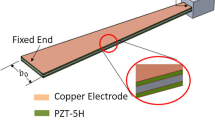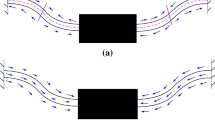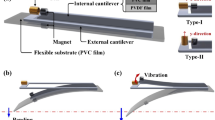Abstract
In this work, we presented a piezoelectric energy harvester adopt a new two-degree-of freedom that can work at both 1st and 2nd resonant frequency. First, the inherent frequency the displacement situation were described through the Finite element simulation software. Subsequently, this device was achieved by bonding the thinned PZT onto a flexible phosphor bronze substrate, and lancing a U-shaped in order to constitute the two degree freedom structure. Two additional tungsten mass were respectively assembled at the tops of the main beam and the second beam to reduce the 1st and 2nd resonant frequency of the harvester. The experimental results show the maximum open-circuit output voltage and output power of the main beam can reach up 18.8 V when it worked at 1st resonant frequency. For the 2nd resonant frequency, the maximum open- circuit output voltage of second beam can reach up 5.44 V.
Access provided by Autonomous University of Puebla. Download conference paper PDF
Similar content being viewed by others
Keywords
1 Introduction
Energy harvesting plays an important role in the field of low-powered energy supply, such as wireless sensors, micro-actuators, especially in the medical, communications and military fields [1]. The use of energy harvester can reduce the use of batteries, so it is beneficial for the environment. The four main types of energy collection are triboelectric, electromagnetic, electrostatic, and piezoelectric [2]. Compared with other forms, piezoelectric devices have the advantages of small size and high energy density [3]. Meanwhile, the piezoelectric device is able to combine well with MEMS technologies [4], the output performance of piezoelectric devices will be further improved. Compared to a conventional battery, the advantages of piezoelectric MEMS harvester include miniature size, simple structure, great output performance and long lifetime [5]. Hence, many low-power devices can use it as an energy source.
The popular MEMS technologies include sputtering, epitaxial growth, sol-gel spin on, hydrothermal method, and screen printing. The screen printing of MEMS technology is different from the conventional method, because the MEMS screen printing can work at low-temperature environment. In recent years, there are more and more researches use those MEMS technologies on the piezoelectric energy harvester, and have good output performance. Nowadays, several piezoelectric energy harvesters prepared by MEMS technology have been reported. Yi et al. reported a bimorph piezoelectric MEMS harvester via bulk PZT thick films on thin beryllium-bronze substrate, which can work under 77 Hz–88 Hz and have the output voltage of about 9.6 V-105 V, when it work at different accelerations from 0.1 g to 3.5 g [6]. Tian et al. designed a new shaped cantilever with a rectangular hole and based on bulk PZT film, which has a low natural frequency about 34.3 Hz, and the output voltage can arrive at 15.7 V [7]. But those devices only can work at the 1st resonant frequency. If one device can work at more resonant frequency, it will have better output.
In this paper, we design a two-degree-of-freedom structure cantilever for the piezoelectric MEMS energy harvesters, so that this piezoelectric MEMS energy harvesters can work under the 1st and the 2nd resonant frequency.
2 Design of the Cantilever Beam
Cantilever beam structure is the most common structure of piezoelectric energy collector, the advantages of cantilever beam structure include simple structure and easy processing, in addition, the stress produced by the cantilever beam structure under the vibration environment matches the piezoelectric material. Minimize the thickness of the cantilever beam to reduce its resonant frequency. On the other hand, in order to improve the output power, piezoelectric materials should obtain greater stress in the process of vibration. The two-degree-of-freedom structure made by cutting technology is used here. Figure 1 shows the surrogate model of two-degree-of-freedom cantilever beam. Which include piezoelectric function PZT layer, phosphor bronze substrate supporting layer, and proof masses of integrated silicon and assembled tungsten. The main beam of this two-degree-of-freedom structure is composed of the external main body of the cantilever beam, the M1 is the proof mass of the main beam, which arranged at the free end of the main beam. Making a u-cut at the center of the main beam, and the free end is opposite to the free end of main beam. This forms the structure of the second beam. The M2 is the proof mass of the second beam, which arranged at the free end of the second beam. The surrogate model was set up as shown in Fig. 1. The structure was simulated by ANSYS software, the result of the finite element simulation is shown in Fig. 2. Firstly, the 1st and 2nd resonant frequency of this structure are 33.463 Hz and 98.294 Hz. Secondly, for the 1st resonant frequency, the maximum displacement of the cantilever beam is at the free end of the main beam (Fig. 2a). For the 2nd resonant frequency, the maximum displacement of the cantilever beam is at the free end of the second beam (Fig. 2b). Therefore, the output performance of the main beam is significant at the1st resonant frequency and the output performance of the second beam is significant at the 2nd resonant frequency.
3 Fabrication of the Energy Harvester
Detailed manufacturing processes are shown in the Fig. 3. The first process was on a 400-μm-thick silicon substrate, and a 2-μm-thick plasma-enhanced chemical vapor deposition (PECVD) SiO2 film was deposited on one side to provide electrical isolation of silicon (Fig. 3a). In order to improve the flexibility and fatigue resistance of the support layer, a 100 μ m-thick phosphor bronze was bonded with prepared silicon substrate (Fig. 3b). The thickness of the phosphor bronze was processed to be 90 μm. A 200-nm-thick Cr/Au was sputtered onto the polished side of the PZT, which is the bottom electrode of the PZT. Then, the conductive epoxy (provided by Shanghai Research Institute of Synthetic Resins) was coated by screen printing, which is as the intermediate layer for bonding bulk PZT with phosphor bronze substrate. Control the thickness of conductive epoxy less than 3 nm, and solidify it in a vacuum of 175 ℃ for 3 h. The piezoelectric material would be completely depolarized, if it is heated to its Curie temperature. The Curie temperature of the PZT used in this work is 295 ℃ (Fig. 3c). The whole process of this work at low temperature. The bulk PZT is thinned down to about 40 μm by mechanical lapping, in order to reduce the resonant frequency of cantilever structure energy harvester (Fig. 3d). Meanwhile, the bulk PZT is also polished to avoid the small holes and scratches on PZT, and improve the adhesion between the PZT film and the top electrode. A 200-nm-thick Cr/Au was sputtered as the top electrode onto upper surface of PZT (Fig. 3e). Using ion beam milling to separate the top and bottom electrodes. Retained part of the silicon substrate as proof mass by deep reactive ion etching (DRIE) process from the backside (Fig. 3f). The two-degree-of-freedom structure is patterned by ultraviolet irradiation from the backside, the specific process is to cut a U shape (Fig. 3h). Two additional tungsten masses were assembled at the free end of the main part of the cantilever beam and the free end of the U shape (Fig. 3g). The addition of two masses can further reduce the 1st and the 2nd resonant frequency of this device. Last, making a scratch on the root the second beam by ultraviolet irradiation, in order to let two beams has their own top electrode (Fig. 3h). Figure 3(a) shows the cross-sectional view of the composite cantilever. The main beam top electrode, the second beam top electrode and the bottom electrode are educed in copper conductor in PCB, as shown in Fig. 4(b).
4 Testing and the Performance of Energy Harvester
The performance of the piezoelectric MEMS harvester was tested using the experimental setup given in Fig. 5, which includes a waveform generator, an amplifier, a vibrator, an accelerator monitor, and an oscilloscope. The waveform generator generated the vibrating signal and amplified by the amplifier to control the vibration of the vibrator, our device vibrated with it. While the vibration acceleration was monitored by the accelerator monitor. The output of the piezoelectric MEMS harvester under different frequency was monitored with the oscilloscope.
According to the test, the open-circuit voltage of the main beam and the second beam are shown in Fig. 6. The device was tested at accelerations from 0.5 g to 2 g. Both beam’s maximum open circuit voltages increased due to the increase of input vibration acceleration. The main beam was tested at 1st resonant frequency, the maximum open-circuit voltages were 6.08 V, 10.4 V and 18.88 V at 28.5 Hz, 28.1 Hz, 27.7 Hz. The second beam was tested at 2nd resonant frequency, the maximum open-circuit voltages were 1.64 V, 4.04 V and 5.44 V at 101.2 Hz, 99.7 Hz and 99.1 Hz. The result shows that the output voltages of both beams are increase with the increasing of acceleration. Meanwhile, the 1st resonant frequency and the 2nd resonant frequency of the energy harvester are both decreased due to the increase of the acceleration of the vibration source. Under the large stress, the damping ratio of PZT increases with the increasing of acceleration due to the nonlinearity character of PZT. Most energy harvester involved in studies can only work at 1st resonant frequency. Last, our test result suggest that the two-degree-freedom structure energy harvester can adapt to different frequency environments.
5 Conclusions
In conclusion, we designed a new two-degree-of-freedom structure piezoelectric energy harvester and presented the fabrication of it. This device can operable at the 1st and 2nd resonant frequency. When the device work at 1st resonant frequency about 33 Hz, the maximum open-circuit voltage was 18.88 V. When the device work at 2nd resonant frequency about 100 Hz, the maximum open-circuit voltage was 5.44 V.
The research work of improvements in the output power and the power density for this device are under way.
References
Erturk, A., Inman, D.J.: Piezoelectric Energy Harvesting. Wiley, Hoboken (2011)
Becher, P., Hymon, E., Folkmer, B., et al.: High efficiency piezoelectric energy harvester with synchronized switching interface circuit. Sens. Actuators A: Phys. 202, 155–161 (2013)
Roundy, S., Wright, P.K.: A piezoelectric vibration based generator for wireless electronics. Smart Mater. Struct. 13, 1131–1142 (2004)
Emad, A., Mahmoud, M.A.E., Ghoneima, M., Dessouky, M.: Testing and evaluation of stretching strain in clamped–clamped beams for energy harvesting. Smart Mater. Struct. 25, 115006 (2016)
Jung, H.J., Jabbar, H., Song, Y., Sung, T.H.: Hybrid-type (d33 and d31) impact-based piezoelectric hydroelectric energy harvester for watt-level electrical devices. Sens. Actuators, A 245, 40 (2016)
Yi, Z., Yang, B.: High performance bimorph piezoelectric MEMS harvester via bulk PZT thick films on thin beryllium-bronze substrate. Appl. Phys. Lett. 111, 013902 (2017)
Tian, Y., Yang, B.: A low-frequency MEMS piezoelectric energy harvester with a rectangular hole based on bulk PZT film. J. Phys. Chem. Solids 117, 21–27 (2018)
Acknowledgments
This work was supported by the National Natural Science Foundation of China (51565038) and the Science Fund of Jiangxi Province Office of Education of China (GJJ151130, GJJ170986).
Author information
Authors and Affiliations
Corresponding author
Editor information
Editors and Affiliations
Rights and permissions
Copyright information
© 2019 Springer Nature Switzerland AG
About this paper
Cite this paper
Xie, G., Tang, G., Li, Z., Yan, X., Xu, B., Deng, X. (2019). A Piezoelectric MEMS Harvester Suitable Adopt a New Two-Degree-of-Freedom Structure. In: Tang, Y., Zu, Q., Rodríguez García, J. (eds) Human Centered Computing. HCC 2018. Lecture Notes in Computer Science(), vol 11354. Springer, Cham. https://doi.org/10.1007/978-3-030-15127-0_20
Download citation
DOI: https://doi.org/10.1007/978-3-030-15127-0_20
Published:
Publisher Name: Springer, Cham
Print ISBN: 978-3-030-15126-3
Online ISBN: 978-3-030-15127-0
eBook Packages: Computer ScienceComputer Science (R0)










